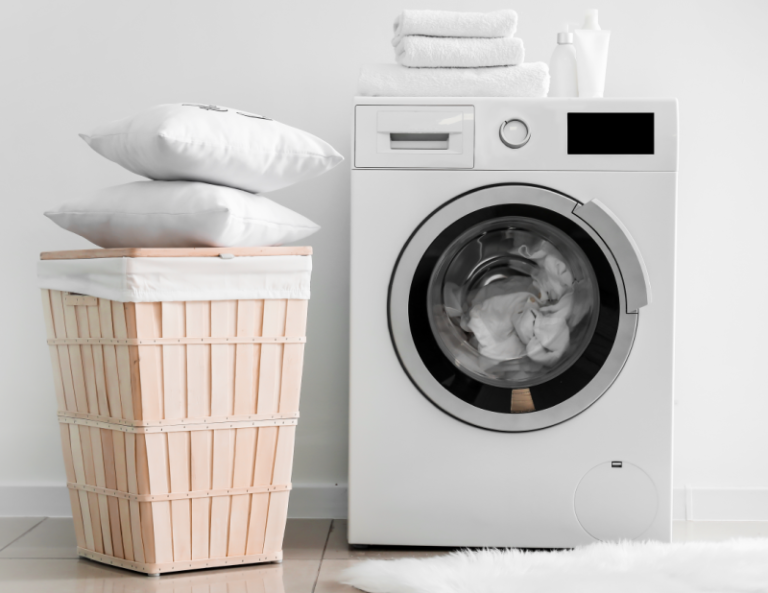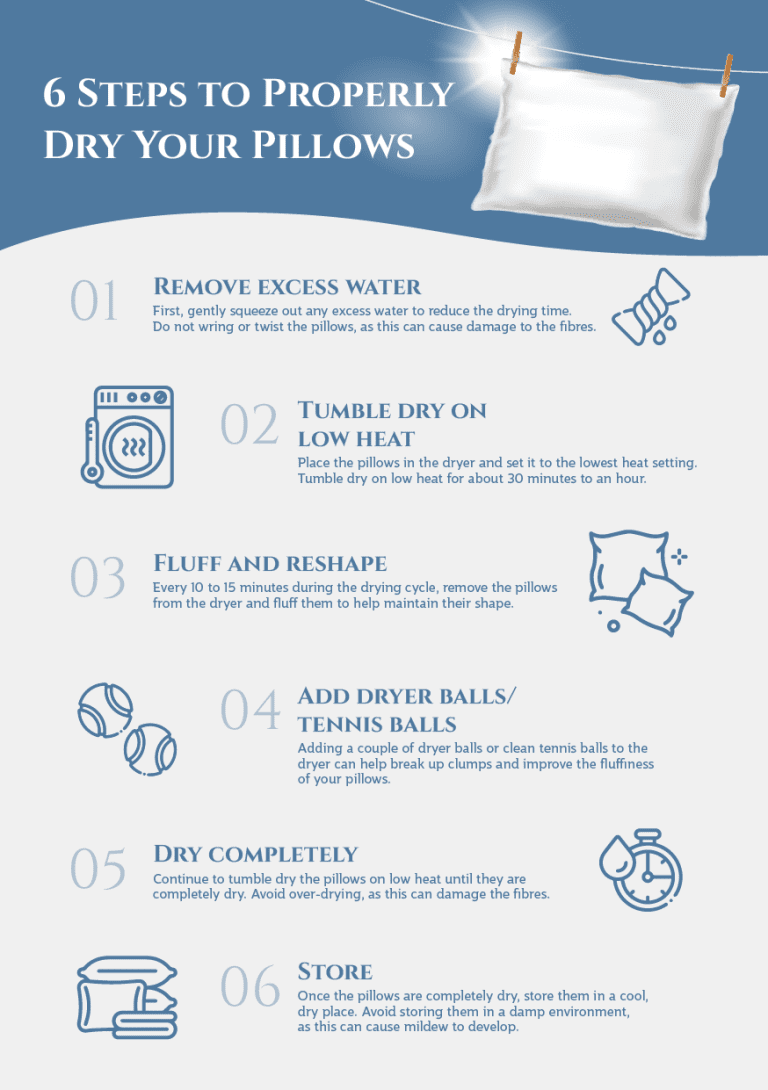
Pillows are one of the most used items on your bed, yet they’re often overlooked when it comes to regular cleaning. Just like your mattress and sheets, pillows collect dirt, oil and sweat, which can lead to unwanted odours, skin irritation and even trigger allergies. In this article, we’ll walk you through the steps of how to clean your pillows and keep them fresh for a better night’s sleep.
How Often Should You Wash Your Pillow
Experts suggest washing your pillows every 6 months or twice a year to keep them fresh and free of allergens. However, for certain circumstances, such as eating in bed, having pets, having sensitive skin or experiencing excessive sweating, it’s recommended that you wash your pillows every three months. The same goes for special pillows like body pillows or throw pillows.
Below are some signs that indicate it’s time to wash your pillows:
- Your pillow or pillow cover is turning yellow
- Your pillow emits a strong unpleasant odour
- Your pillow feels less comfortable or fluffy
What You’ll Need
If you’re planning to wash your pillow, these are the items that you’ll need for the tips that we will be sharing later on:
- Mild Laundry detergent
- Stain pre-treatment spray or mild soap
- Dryer balls or tennis balls
- A washing machine
How To Wash Your Pillows in the Washing Machine
The easiest way to clean your pillows is by using a washing machine. Here are the basic steps on how to machine wash your pillows. But before throwing them in the washer, please check the label first to ensure they can be machine washed!
#1 Spot-Treat Noticeable Stains
Before tossing your pillows in the washing machine, check for any prominent stains that may need extra attention. Generally, a cloth dipped in a mild soap solution is used for foam pillows as the wet foam tears easily. For other types of pillows with food stains or stains from bodily fluids like blood or saliva, using a spray containing enzymes would easily remove them.
Overall, spot-treating noticeable stains on your pillow is a simple step that can help improve the effectiveness of the cleaning process.
#2 Put Your Pillows Into The Washing Machine
Once you’ve finished spot-treating, you can start loading your washing machine with pillows. Experts highly recommend front-loader washing machines for washing pillows, but if you own a top-loader washer, ensure that you position the pillows vertically to prevent them from getting tangled. You might also want to consider washing two pillows at a time or adding other stuff like towels (Note: Check your pillow’s care instructions first if it needs to be washed on its own!) to balance out your washing machine.
#3 Gently Wash with Cool or Warm Water & a Mild Detergent
Gently washing your pillow with cool or warm water and a mild detergent is an effective way to keep it clean and fresh. When selecting a detergent, it’s important to choose one that is gentle and free of harsh chemicals, such as bleach or fabric softeners, which can damage your pillow’s fibres.
To wash the pillow, simply place it in the washing machine with a small amount of detergent and set the water temperature to either cool or warm, depending on the care label. It’s also important to use a delicate or gentle cycle to avoid excessive agitation and further wear and tear on the pillow. Doing these will help preserve its quality and ensure a comfortable, clean sleeping surface for yourself.
#4 Run a Second Rinse Cycle If Necessary
If your pillow still feels soapy after being washed in the machine, it’s a good idea to run a second rinse cycle. The purpose of the rinse cycle is to remove any remaining soap from the pillow, and a second rinse can ensure that all soap residue has been removed. Leaving soap residue on your pillow can cause skin irritation, as well as attract dirt and dust, making your pillow less clean and fresh over time.
To run a second rinse cycle, simply add water to the machine and run it for a full cycle without any detergent. By doing this, you’ll help your pillow come out of the wash feeling soft and clean, ready for use.
#5 Properly Dry Your Pillows
It’s important to dry your pillows properly after washing to maintain their quality and ensure a healthy and comfortable sleeping surface. Neglecting to dry your pillows properly can result in clumping, flattening, musty odours and health hazards. The following are some simple and effective steps to drying your pillows the right way:
- Remove excess water: First, gently squeeze out any excess water to reduce the drying time. Do not wring or twist the pillows, as this can cause damage to the fibres.
- Tumble dry on low heat: Place the pillows in the dryer and set it to the lowest heat setting. Tumble dry on low heat for about 30 minutes to an hour.
- Fluff and reshape: Every 10 to 15 minutes during the drying cycle, remove the pillows from the dryer and fluff them to help maintain their shape.
- Add dryer balls/tennis balls: Adding a couple of dryer balls or clean tennis balls to the dryer can help break up clumps and improve the fluffiness of your pillows.
- Dry completely: Continue to tumble dry the pillows on low heat until they are completely dry. Avoid over-drying, as this can damage the fibres.
- Store: Once the pillows are completely dry, store them in a cool, dry place. Avoid storing them in a damp environment, as this can cause mildew to develop.


Washing Different Types of Pillows
While many pillows are washing machine-friendly, some other types of pillows need extra care to ensure that they’ve been thoroughly cleaned without damaging the quality of materials used. Here are some additional cleaning tips for each pillow type:
- Polyester/Synthetic pillows: Polyester is one of the easiest materials to clean. These pillows are safe to machine wash on a gentle cycle using warm water and a small amount of mild detergent. Tumble dry on low heat or air dry. As for Sealy’s range of Gel Luxe Fibre pillows, it is suitable for dry cleaning only.
- Down and feather pillows: Similar to polyester, down or feather pillows can be machine washed on a gentle cycle using cool water and mild detergent. Tumble dry on low heat with a few clean tennis balls to fluff them up.
- Memory foam, latex and gel pillows: These types of pillows should only be spot-cleaned or hand washed with mild detergent and cool water. Air dry, as putting them in the dryer can damage the foam.
- Latex pillows: Latex pillows can be washed on a gentle cycle in the washing machine using cool water and mild detergent. Air dry or tumble dry on low heat.
- Buckwheat pillows: Buckwheat pillows can be emptied, and the cover can be machine washed. The buckwheat filling should be air-dried.
So there you have it folks, with these simple steps, you’ll be sleeping soundly on freshly washed pillows in no time. Happy washing!
Searching for new pillows? You might want to browse Sealy’s range of comfortable and luxurious pillows.



